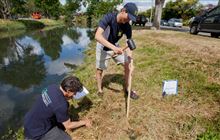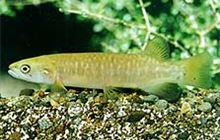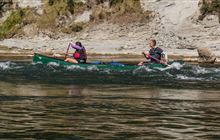Whitebaiting
Introduction
Find out when, where and how to fish for whitebait in New Zealand and the Chatham Islands.When can I whitebait?
Whitebaiting season in New Zealand is closed. Whitebaiting is only allowed during whitebait fishing season. Taking whitebait at all other times is prohibited.
New Zealand whitebaiting season
1 September to 30 October (inclusive).
Chatham Islands whitebaiting season
1 December to the last day of February (inclusive).
In New Zealand and the Chatham Islands whitebaiting is allowed from:
- 5 am to 8 pm
- or 6 am to 9 pm during New Zealand daylight saving.
Whitebaiting fishing guidelines
What's on this page:
- Regulations
- Where you can fish for whitebait
- Whitebait fishing gear
- Using your net
- Whitebaiting on the West Coast
- Resources
Regulations
It’s important all whitebaiters comply with the whitebait fishing regulations as this will help sustainably manage this precious taonga.
This information is based on the Whitebait Fishing Regulations 2021. It is only a guide and does not contain all the rules.
Ensure you’re familiar with Whitebait Fishing Regulations 2021 and watch the helpful short video, 'Whitebaiting Regulations 2021’. You can also print out a whitebait fishing regulations information leaflet in te reo or English.
Read the Whitebait Fishing Regulations 2021
Watch Whitebaiting Regulations 2021
Download Whitebaiter's guide to whitebaiting brochure (PDF, 1,854K) English
Download Whitebaiter's guide to whitebaiting brochure (PDF, 1,863K) Te reo
The Whitebait Fishing Regulations 2021 don’t apply and have never applied to Māori fishing rights exercised by tangata whenua.
Māori fishing rights information sheet (PDF, 447K)
Also note that whitebaiting regulations differ in the West Coast to the rest of New Zealand.
Penalties for not complying with the regulations may result in:
- a $400 infringement fee, or
- prosecution with a maximum penalty of $5000, and
- seizure of your fishing gear.
Where you can fish for whitebait
Whitebaiting is only allowed in tidal waters.
On some rivers, the extent of the tidal waters is marked with a back peg. Fishing for whitebait upriver of these back pegs is illegal.
Fishing for whitebait is not allowed in any national parks anywhere in New Zealand.
Fishing for whitebait is not allowed in a whitebait refuge. There are three regions with whitebait refuges:
Whitebait fishing gear
Fishing gear includes anything that is used for the purpose of whitebait fishing, such as nets, screens, stakes, ropes, and spotter boards. Fishing gear doesn’t include licenced structures, also known as stands.
All fishing gear must be:
- actively monitored so that you can immediately remove and release any species that are not whitebait
- removed from the water every time you move more than 10 m away from the net, even if it’s only to take a break or talk to someone for a short time
- removed from the water when you finish fishing or at the end of the day, whichever comes first
- no more than 6 m in total length, even if used from a licenced structure/stand.
Whitebait nets
Whitebait nets must not:
- be more than 3.5 m in length.
- have a mouth larger than 4.5 m when measured around the inside of the net frame
- have framing material wider than 120 mm.
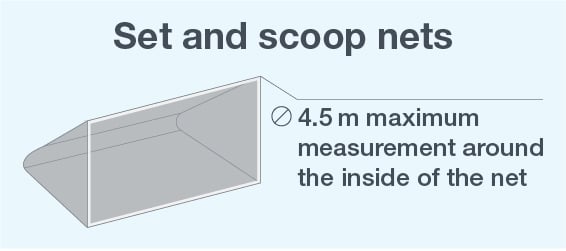
Image: DOC
Drag nets
A ‘drag net’ is any net or any rope, material or device used with the net that is weighted on the bottom edge. A drag net is drawn through the water and surrounds the whitebait.
All drag net type nets:
- must be flat when laid on a flat surface
- must not be more than 1 m in height
- must not be more than 3.5 m in length, and
- must not be used on the West Coast.
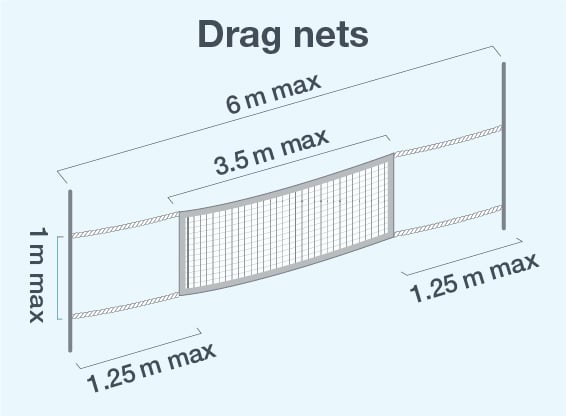
Image: DOC
Screens
Screens are the only device allowed to divert whitebait into a net. Screens must not be more than 3 m in length, unless used from a licensed structure (stand).
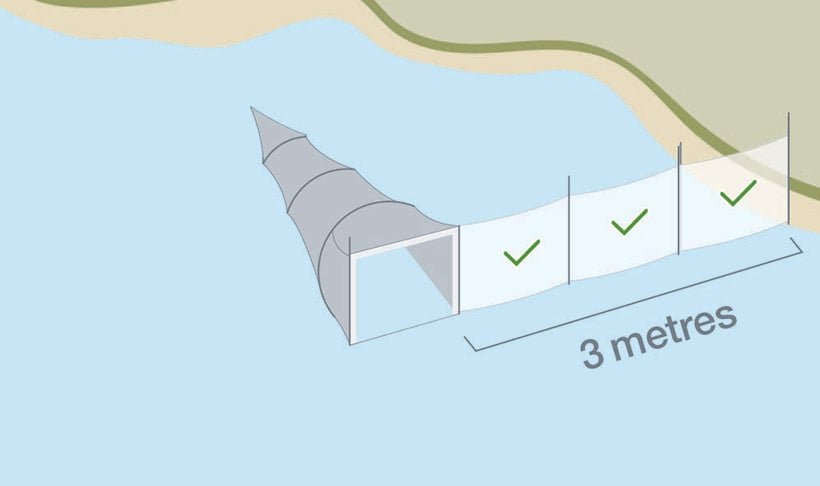
Image: DOC
Using your net
When setting up your gear, any configuration of nets and screens is allowed, except on the West Coast. For example, you could use a 2 m screen, then your net, then a 1 m screen on the outside of your net. See Additional rules - West Coast for the different rules that apply on the West Coast.
Fixed fishing gear doesn’t need to be held in place, it is fixed to the riverbed by stakes.
You must maintain at least 20 m between fixed fishing gear, except when used from a stand. There is no minimum distance between scoop or drag nets.

View higher resolution version (PDF, 120K)
Image: DOC
When whitebait fishing, you must not:
- use more than one net at a time
- be within 20 m of any:
- tide or flood gate
- confluence
- culvert
- weir
- groyne or seawall
- outfall structure, or unlawful diversion.
- fish from a bridge or boat/vessel.
- use gear that takes up more than one quarter of the width of the waterway, either separately or combined with someone else’s gear
- create any diversion or alter or modify the natural bed or banks of any river, stream, estuary or channel.

Image: DOC
Licensed structures (stands)
A licensed structure, commonly called a “stand”, is any structure authorised to be used to fish for whitebait under the Resource Management Act 1991. The licensing of stands is managed by regional councils.
If you are whitebaiting from a licensed structure, you are only allowed to use:
- one net at a time
- a maximum fishing gear length of 6 m, including screens, ropes, nets, and pulley arrangements.
In the West Coast, only one net must be used from a stand. See Additional rules - West Coast. for more information.
Additional rules - West Coast
If you are fishing for whitebait on the West Coast, some specific rules apply:
- Screens must always be set from the water’s edge. To keep the screens at the water’s edge, they must be moved with the ebb and flow of the tide.
- Screens must never be on the outside of the net. They can only be on the bank side. Do not place a screen beyond the whitebait net.
- Screens must not extend beyond the outer edge of the structure.
- Nets set from licenced structures (stands) must be in a straight line with the edge of the structure.
- Only one net must be used from a licenced structure (stand), whether by the fisher or any other person using that structure. This includes scoop nets as well as set nets.
- You must not use drag nets on the West Coast.
Resources
Report illegal activity.
It's important we all fish responsibly and sustainably. If you see anyone illegally whitebaiting, contact us on 0800 DOC HOT (0800 362 468).
Children's whitebait activity sheet and activity book
Learn about whitebait in these activity sheet and booklet below. Run the maze, complete the word search, play the Whitebait Quest game with your family. You can also design your own native fish.
Whitebait activity sheet (PDF, 4,400K) This file should be printed on A3 paper.
Love NZ whitebait activity book (PDF, 6,374K) This file should be printed on A4 paper.
If you don't have a printer or can't print the right size, email whitebait@doc.govt.nz with your name and full address. We'll post one to you.
Help whitebait thrive
Whitebaiting is a classic Kiwi past time that gets people outdoors with whanau and friends. Find out what you can do to help sustain the future whitebait fishery.
Whitebait - migratory galaxiids - You can help
Biosecurity for whitebaiters
Moving between waterways has the potential to spread freshwater pests such as gold clam, didymo, and lindavia (lake snow), that can clog nets and choke waterways, including whitebait habitats. Protect New Zealand’s waterways by following the Check, Clean, Dry method.
If you're whitebaiting in the Waikato River, follow the special advice for preventing the spread of freshwater gold clam below.
Waikato Check Clean Dry update for whitebaiters (PDF, 291K)
Waikato Check Clean Dry update for power boats (PDF, 353K)
Regulations and consultations
This report records whitebaiters describing themselves and their fishing experience. It includes why and where they fish, what gear they use, and what impacts the recent regulation changes have had on their fishing. The data collected will help identify the issues of most concern to whitebaiters and inform future whitebait fishing practices.
Perceptions of Aotearoa New Zealand whitebait fishery 2022 (PDF, 9,269K)
The whitebait regulations were changed in 2021 to improve sustainability by reducing fishing pressure on whitebait species and native fish by-catch. Read about the consultation below.
Whitebait Regulations consultation 2021
This report details the information gathered, nationally and at pilot sites, during the 2021 whitebait season, to inform a more comprehensive approach for future seasons.
2021 whitebait season information capture (PDF, 13,900K)
Contacts
Contact your local DOC office for more information or email whitebait@doc.govt.nz.

